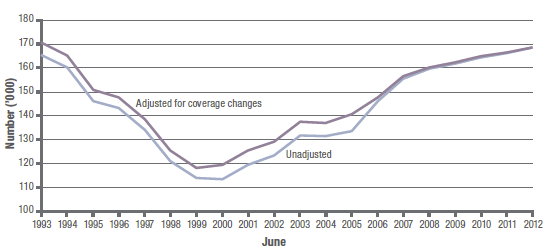Dr Nicholas Horne, Politics and Public Administration
Key issue
Australian Public Service (APS) employment and staffing levels are a perennial public administration issue. The efficiency dividend has also been a high-profile issue in recent years. |
Staffing reductions
As part of a package of public sector savings measures, the 2013–14 Budget specified a $148.4 million reduction in APS employment expenditure at the executive levels (EL 1–2 and SES) over 2013–17; media reporting estimated staffing reductions of up to 400 positions. The Budget also estimated total APS-wide staffing reductions in 2013–14 of 1,262 full-time equivalent positions (excluding increases in military and reserve personnel).
Subsequently, in July 2013 the Government announced reductions at the APS executive levels of around 800 staff over 2014–18 as a savings measure further to the introduction of the emissions trading scheme. It is unclear whether these reductions are additional to the reductions specified in the Budget.
For 2013–14, the August 2013 Pre-Election Economic and Fiscal Outlook estimates $235 million less in General Government Sector (GGS) wages and salaries expenditure than the Budget, and $771 million less over 2014—16 before a projected increase in 2016—17. However, it is worth noting that for at least the last five years, actual GGS wages and salaries expenditure has increased annually, possibly due to APS staffing growth and annual salary increases.
Employee numbers
According to Australian Public Service Commission (APSC) data, between June 2007 and June 2012 the APS (staff employed under the Public Service Act 1999) experienced modest growth, rising from 155,424 employees in June 2007 to 168,206 employees in June 2012—an increase of 12,782 with an average annual growth rate of 1.64%. Over 2007—12, the number of employed persons grew by an annual average of 1.40%.
APSC data also indicates that between 2007 and 2012 ongoing total SES staff numbers increased by 20.71%, whereas ongoing EL 1 and EL 2 staff numbers increased over the same period by 34.28% and 23.56% respectively.
Further according to APSC data, at 31 December 2012 the APS had 165,598 employees. This constituted a small decrease of 2,608 (minus 1.55%) from the 30 June 2012 total.
Enterprise agreements
In 2011 the Government introduced a new employment bargaining framework for APS employees which recommended a nominal expiry date of 30 June 2014 for agency enterprise agreements. The framework also featured recommended common terms and conditions for inclusion in agreements.
The negotiation of new enterprise agreements will be a significant activity within the APS in 2013–14.
The efficiency dividend and outsourcing review
In 2012–13, the efficiency dividend, an annual funding reduction for agencies, was applied at an increased rate of 4.0% (up from a rate of 1.5% in 2011–12). The 2013–14 Budget eased the impost for agencies by reducing the dividend rate to 1.25%.
In its August 2013 Economic Statement the Government announced a 1.0% increase in the efficiency dividend rate to 2.25% per annum over 2014–17; the increase is estimated to result in savings of $1.8 billion.
There has been some reporting of projected staffing reductions due to the increase, for example, at the Department of Health and Ageing. The Government also indicated that, if returned, it would task the APSC with reviewing Commonwealth outsourcing arrangements.
Amendments to the Public Service Act 1999
In July 2013, substantial amendments to the Public Service Act 1999 came into effect (passed by the Parliament in February 2013). Changes include new arrangements for the appointment of secretaries, revised APS Values and new APS Employment Principles and extended application of the Code of Conduct in relation to breaches of the Code.
Coalition policies
Since 2010, the Coalition has maintained a policy of reducing APS employee numbers by some 12,000 over two years through natural attrition in order to realise savings.
The Coalition has promised that if it were elected, it will establish a Commission of Audit to review government operations. In addition, under its productivity and regulation policy, a Coalition Government would: require agencies to reduce regulation, with performance targets for departmental secretaries and the remuneration of SES employees would also be linked to regulation reductions. It would also reportedly reintroduce performance bonuses for SES employees.
Following the 2013 election, Prime Minister Tony Abbott, has announced additional savings measures and significant Machinery of Government (MoG) changes. The additional savings include the abolition of environmental bodies and the integration of AusAID into the Department of Foreign Affairs and Trade. In reference to the MoG changes, Mr Abbott said that the changes to departmental structure ‘will simplify the management of government business, create clear lines of accountability and ensure that departments deliver on the Government’s key priorities’.
APS employee numbers 1993–2012
Source: Australian Public Service Commission (APSC), State of the Service Report 2011–12, APSC, Canberra, 2012.
Further reading
T Abbott (Prime Minister), The Coalition will restore strong, stable and accountable government, media release, 18 September 2013.
C Bowen (Treasurer) and P Wong (Minister for Finance and Deregulation), Economic statement August 2013, media release, 2 August 2013 and Transcript of press conference, Canberra, media release, 2 August 2013.
Liberal Party of Australia and The Nationals, The Coalition’s policy to boost productivity and reduce regulation, Coalition policy document, July 2013.
B Shorten (Minister for Workplace Relations), Address to CPSU members, Melbourne, media release, 16 August 2013.
For copyright reasons some linked items are only available to members of Parliament.
© Commonwealth of Australia